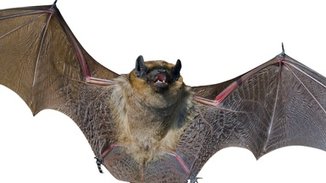Smooth vertical surfaces like windows reflect sound waves away from bats—meaning bats can't "see" windows and similar obstacles with echolocation. Christopher Intagliata reports.
像玻璃这样光滑垂直的平面会将声波反射得远离蝙蝠——也就是说,蝙蝠无法再用回声定位法“看见”窗户这类障碍物了。
撰文/播音 Christopher Intagliata克里斯托弗·因塔利亚塔
翻译 张清越
审校:郭晓
Just as humans understand the shape of our surroundings by how light reflects off objects, bats use reflections of sounds they produce instead—what’s called echolocation. But despite their excellent sensing abilities, one type of obstacle vexes the animals: smooth vertical surfaces, like windows. Because windows reflect almost all the bats’ calls away from bats at an angle—creating the illusion of empty space.
人类靠物体反射的光来感知周遭的环境,而蝙蝠则是靠它们产生的声音的反射达到同样的作用:这就是回声定位法。然而,尽管它们对声波的感知尤为敏感,有一种障碍物却使它们束手无策:那就是光滑的垂直面,例如窗户玻璃。由于窗户可以从一种角度将蝙蝠发出的几乎所有声波都反射到别处,这样就会给蝙蝠造成前方一片空旷的幻觉。
"To better understand it you can actually use a visual analogy." Stefan Greif, a sensory ecologist at the Max Planck Institute for Ornithology. Imagine standing in a dark room, he says, beside a mirror. "If then if you take a flashlight in your hand and shine it on the side onto this mirror, you would see that all the light is reflected away. You'd see it on the other side of the wall. So even visually this would look to you like there's a hole in the wall. There's nothing coming back from this place."
“如果想要更好地理解这个原理,你可以用一个视觉类比。”马克思普朗克鸟类研究所的感知生态学家斯蒂芬·格雷夫(Stephan Greif)如是说道。他告诉我们,假设自己站在一间黑屋里,身旁有面镜子。“如果你手里拿着一个手电筒,然后从侧面照向镜子,你会发现所有光都被反射开了。你会看到光线出现在了镜子对面的墙上。所以即使从视觉上来说,这面墙看起来像中央有个窟窿似的,但是实际上没有任何光线从窟窿中出来。”
Light wouldn't come back to you unless you aimed the flashlight more or less perpendicular to the mirror—and same for bats and their calls. This perceptual glitch meant that in lab tests 90 percent of bats banged into a smooth vertical surface. (And by the way, the researchers say that none were hurt.) But here's the interesting bit: bats never smashed into a smooth horizontal surface.
除非你或多或少地把手电筒垂直对准镜子,否则光都不会向你反射回来——这跟蝙蝠和它们发出的声波是一样的。这一感知缺陷导致实验中90%的蝙蝠都撞上了光滑的垂直面(顺便提一下,科学家称此实验未对任何蝙蝠造成伤害)。有趣的是:蝙蝠从来不会撞上光滑的水平面。
Greif says that's because plenty of horizontal planes exist in nature, like lakes and ponds. And even though a lake reflects calls away from the bat, bats have evolved to perceive the absence of sound reflections from horizontal surfaces as water. In fact previous studies have shown that bats will actually dip down for a drink from smooth horizontal surfaces—whether they're water-filled or not. The study is in the journal Science. [Stefan Greif et al., Acoustic mirrors as sensory traps for bats]
格雷夫告诉我们,这是因为自然界中广泛存在着水平面,例如湖泊和池塘。因此,虽然湖泊也会把蝙蝠的声波反射开,但在漫长的进化中,蝙蝠已经把缺失回声的水平面当作水面了。事实上,过去的研究发现,蝙蝠确实会掠过光滑水平面饮水——无论那里是否真的有水。这篇文章发表在《科学》杂志中。
So what are conservationists to do? "Obviously we have to be realistic, right? We can't start making all our windows rough and textured." But if we build near crucial bat habitats, we could install acoustic deterrents to drive the flying mammals away from buildings. "And certainly you could start looking at architectural possibilities, if you don't make a smooth surface smooth all the way but make ridges inside, like a mosaic." And perhaps bat-friendly architecture would result in new designs…pleasing to human perception, too.
那么自然保护者们会为此采取哪些行动呢?“我们显然要考虑现实因素,不是吗?我们不可能把窗户都做成粗糙不平有纹理的平面。”但当我们在重要的蝙蝠栖息地周边造建筑物时,我们可以安装声波阻碍物,让这些翱翔于天空的小哺乳动物们远离楼房。“当然,我们也可以开始寻找建筑学上的解决策略,例如在光滑表面的内部做出起伏,像马赛克一样。”或许蝙蝠友好型的建筑将成为设计新潮流——同时也满足人类感官。

 京公网安备11010502039775号
京公网安备11010502039775号  京公网安备11010502039775号
京公网安备11010502039775号 
















